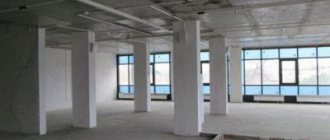What it is?
A non-residential building is a building that is not intended for human habitation. Although the legislation of the Russian Federation does not contain the concept of this object, it establishes the main features by which it can be identified.
So, according to Art. 15 of the RF Housing Code for non-residential premises is characterized by the following:
- It must relate to real estate.
- It must be insulated (the means of insulation in this case are the integral parts of each room: ceiling, walls and floor; an equipped entrance/exit is required).
- Must be suitable for habitation.
What is this “free-use premises”? This concept is used in commercial slang. You will not find it in any law or in any official document. It appears very often in advertisements. It refers to small buildings or parts thereof that are not intended for habitation. Their goal is to equip a cafe, or a store, or an office, or a warehouse, and so on.
Important! The main thing is that the registration documents include a note that the premises belong to the non-residential property.
With this status, the advertiser wants to convey to potential clients that the purpose of the premises is not defined, and therefore the latter have greater freedom in its use. There are plenty of options for using a free space. However, they should not be considered universal.
Once it reaches a specific goal, a lot of nuances will emerge that require redevelopment, additional approvals, and re-issuance of documents.
What is a change in target operation?
Non-residential premises are intended for social, commercial, administrative, cultural, educational and other purposes. The main taboo is the ban on living in it.
Thus, based on the requirements of current legislation, accommodation is not intended use. There is another type of misuse. These are cases when the owner of the leased property indicates the intended use in the agreement.
If, according to the contract, the tenant took the buildings for a warehouse and set up a beauty salon there, then this operation will also be classified as not intended for its intended purpose. There is no specific article that would establish the limit and responsibility for its use for other purposes, either in the Criminal Code of the Russian Federation or in the Code of Administrative Offenses of the Russian Federation. The only obstacle to misuse is the specific requirements for each type of non-residential building.
These requirements are detailed in GOSTs and Codes of Practice. For example, GOST R EN 13779-2007 “Ventilation in non-residential buildings. Technical requirements for building ventilation and air conditioning systems”, GOST 30494-2011 “Residential and public buildings. Indoor microclimate parameters"; SP 158.13330.2014 “Buildings and premises of medical organizations. Design Rules"; SP 2.13130.2012 “Fire protection systems. Ensuring the fire resistance of protected objects.”
How to change the purpose of a building or premises?
To begin with, let's say that buildings have purposes: residential building, non-residential building, apartment building, residential building and garden house. Premises are residential and non-residential.
According to Part 1 of Article 32 of Law No. 218-FZ, state authorities and local governments are required to send documents (the information contained in them) to the rights registration authority for entering information into the Unified State Register of Real Estate if they make decisions to transfer residential premises to non-residential premises, non-residential premises to the residential premises (if redevelopment work is not required) or on approval of the acceptance committee act (in the case of redevelopment work).
If the information is not entered into the Unified State Register of Real Estate within the time limits established by Article 34 of Law No. 218-FZ, the interested person has the right, in the manner established for submitting an application for state cadastral registration and (or) state registration of rights, to contact the rights registration authority with an application for entering the relevant information into the Unified State Register of Real Estate.
Let us note that the rights registration authority, within 3 working days from the date of receipt of the application for entering the relevant information into the Unified State Register, independently requests documents from state authorities and local governments.
Situations where a house was built on a garden plot of land, which is intended for seasonal use, that is, non-residential purposes, and subsequently converted in such a way that it became possible to live in such a house all year round, occur regularly.
Until recently, changing the use of a garden house was a problem for its owners. However, thanks to the Law on Gardening and Horticulture No. 217-FZ, which has been in force since 2019, it is possible to recognize a garden house as a residential building and vice versa.
To do this, the owner of the house must contact the local government, submitting the following documents:
- application, title document for a garden house or residential building;
- conclusion on the inspection of the technical condition of the object, confirming the compliance of the garden house with the requirements of reliability and safety (established by Part 2 of Article 5, Articles 7, 8 and 10 of the Federal Law “Technical Regulations on the Safety of Buildings and Structures”);
- notarized consent of third parties (if the property is encumbered with the rights of these persons).
Each municipality can independently establish an additional list of documents, so the full list of documents can be found on the official websites of municipalities.
After receiving the Decision, the owner of the building applies to Rosreestr with an application to change the purpose of the property.
Concepts of direct and functional use
The intended purpose is a mark in the registration documents of non-residential premises, characterizing its status. The intended purpose directly indicates how a specific non-residential area can be used.
Thus, in the design documents of buildings, a note can be made that specific premises should be equipped and used as pharmacies, shops, hairdressers, offices, dental offices, etc. At the same time, they must be equipped in accordance with all sanitary and fire safety standards.
Important! On the one hand, such planning prevents the chaotic development of retail outlets and regulates competition. On the other hand, a non-residential object receives a label, and with it a strict restriction on its further use, which reduces the demand for it significantly.
The functional purpose is inherent in the technical characteristics of the room itself and its change is of a different nature. If the intended purpose can be nominally established in the documents, then the functional purpose is dictated by the location of the object, its decoration, its area, etc., and therefore changing the purpose of such a room is more labor-intensive. This can be explained with an example like this. Premises are rented for the purpose specified by the owner - a cafe. Moreover, among them there should be rooms with a functional purpose - a kitchen.
In this case, the kitchen must comply with all legal requirements. For example, be equipped with appropriate ventilation and finished with suitable tiles. The use of non-residential premises has a wide range. From pharmacies and shops to gyms and medical facilities. Therefore, the requirements for the arrangement of premises vary for each type of use. Thus, you can change the functional purpose, the only question is how to do this with less loss of money and effort.
Problems of changing the purpose of accounting objects
In accordance with paragraphs 15,16,18 of part 2 of article 7 of the Federal Law “On the State Real Estate Cadastre” dated July 24, 2007. No. 221-FZ (hereinafter referred to as the Cadastre Law) the following are entered into the state real estate cadastre:
- purpose of the building (non-residential building, residential building or apartment building), if the property is a building;
— purpose of the structure, if the property is a structure.
According to the Procedure for maintaining the state real estate cadastre, approved by order of the Ministry of Economic Development of the Russian Federation dated 02/04/2010 No. 42 “On approval of the Procedure for maintaining the state real estate cadastre” (hereinafter referred to as the Procedure for maintaining the State Real Estate Cadastre), clause 8, subparagraph 1 of section II Structure and composition of cadastral information of the Register of Real Estate General information about the property is entered into the record about the property in the amount provided for in paragraphs 63, , , and of the Procedure for Maintaining the State Property Committee.
In accordance with Part 2 of Article 16, cadastral registration in connection with a change in the unique characteristics of a real estate property or any specified in paragraphs 7, 13 - 20, 25 - 29 of Part 2 of Article 7 of the Law on Cadastre Information is carried out, unless otherwise provided by the Law on Cadastre, on the basis of an application for cadastral registration and the documents submitted by the applicant or submitted in the manner of interdepartmental information interaction necessary in accordance with the Cadastre Law to carry out such registration.
As follows from paragraph 10 of part 1 of Article 22 of the Cadastre Law, the document required to enter or change information about the purpose is a copy of the document confirming, in accordance with the Cadastre Law, a change in the purpose of the building or premises. Such documents may be requested by the cadastral registration authority in the manner established by Part 5 of Article 16 of the Cadastre Law, i.e. in the order of information interaction.
Accordingly, if the cadastral registration body receives an application for cadastral registration in connection with a change in the purpose of a building, premises and at the same time the relevant documents are not received from the authorized state authority or local government body in the order of information interaction, the cadastral registration body independently requests such documents, if such documents were not submitted by the applicant on his own initiative.
When processing applications received by the cadastral registration authority in connection with a change in the purpose of a building or premises, the following problems arise:
1) Lack of information about the cadastral number of the registration object in the acts of local self-government bodies (hereinafter referred to as LGUs) (not often, but there are cases).
Whereas, in accordance with paragraph 9 of the Decree of the Government of the Russian Federation dated 02/03/2014 N 71 “On approval of the Rules for sending by state authorities and local governments of documents necessary for entering information into the state real estate cadastre, to the federal executive body authorized in the region state registration of rights to real estate and transactions with it, cadastral registration and maintenance of the state real estate cadastre, as well as the requirements for the format of such documents in electronic form" in the case of transfer of residential premises to non-residential premises, non-residential premises to residential premises, the local government body sends to cadastral registration authority a document reproducing the information contained in the decision to transfer residential premises into non-residential premises, non-residential premises into residential premises, including the cadastral number and purpose of the premises in respect of which the transfer is being carried out, or a document reproducing the information contained in the acceptance commission act, confirming the completion of reconstruction and (or) redevelopment and (or) other work (if such transfer required reconstruction, redevelopment or other work in relation to the premises).
2) When transferring from residential to non-residential premises (or vice versa), the order/resolution of the compulsory medical insurance indicates the area of the residential premises without taking into account the balcony, loggias, or vice versa, when transferring to residential from non-residential premises, the area is indicated taking into account cold rooms (loggias, balconies).
However, in accordance with Order No. 531 of the Ministry of Economic Development of the Russian Federation dated September 30, 2011 “On approval of the Requirements for determining the area of a building, premises” (hereinafter referred to as Order No. 531), the total area of a residential premises, residential building consists of the sum of the area of all parts of such premises, residential houses, including the area of auxiliary premises intended to satisfy citizens' household and other needs related to their residence in residential premises, with the exception of balconies, loggias, verandas and terraces.
Thus, specialists authorized to carry out cadastral registration of real estate objects have to independently determine the area of the premises in accordance with Order No. 531.
3) In regulations, instead of purpose, they write the intended purpose, functional use, etc.
4) The object of registration in the state real estate cadastre is a building, but the decree indicates the premises and vice versa.
5) The state real estate cadastre contains information about a building with the designation “non-residential building” and the name “cafe”. The owner wants to change the name from “cafe” to “shop”. At the same time, the local government authority stipulates in the resolutions “... to change the purpose of the building for use for the purposes of a store...”. Whereas in this case, the purpose of the building does not change, but only the name changes.
6) Part 8 of Article 23 of the Housing Code of the Russian Federation “The procedure for transferring residential premises into non-residential premises and non-residential premises into residential premises” provides that if the use of premises as residential or non-residential premises requires its reconstruction, and (or) redevelopment, and (or) carrying out other work, then the decision to transfer the premises is the basis for carrying out the corresponding reconstruction work, and (or) redevelopment, taking into account the reconstruction and (or) redevelopment project.
The completion of the reconstruction, and (or) redevelopment, and (or) other work specified in Part 8 of Article 23 is confirmed by an act of the acceptance commission formed by the body carrying out the transfer of premises (hereinafter referred to as the act of the acceptance commission).
The acceptance committee’s act confirming the completion of the reconstruction and (or) redevelopment must be sent by the body carrying out the transfer of premises to the body carrying out state registration of real estate objects in accordance with the Cadastre Law. The acceptance committee's act confirms the completion of the transfer of the premises and is the basis for using the transferred premises as residential or non-residential premises.
However, local government authorities in this case often send to the cadastral registration authority only the decision to transfer the premises (for example, from non-residential to residential), whereas in accordance with the Housing Code of the Russian Federation they must send an Acceptance Commission Report.
In connection with the above, we inform you that the existing problems that arise when processing documents received from local governments entail a violation of the Cadastre Law. This fact, as a consequence, leads to the subsequent adoption of decisions on the suspension/refusal of cadastral registration in terms of changes in the purpose of the property (building, premises).







